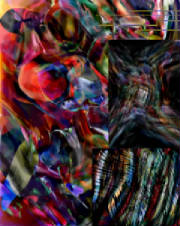So, you’re
wondering, what are the big good things...and big bad things?
First, two bad things. In digital you give up the unique, hard-to-counterfeit object, e.g., real
oil paint on real canvas that the artist actually touched. Consider photographs and lithographs, the world of multiple copies--digital
is part of that world. Many artists don’t number their prints; I’ve settled on editions of 10 as a compromise
(there’s some scarcity but I don’t have to charge much for the first numbers). A few artists paint on the digital
print and call the result mixed media. Then you are back to the unique object but it won’t have the permanence of oil
or some other media.
Another bad thing
is that computers are so powerful and perform so many neat tricks so quickly, people get two wrong impressions: the machine
is making the art; and any child can do it. Everybody knows that word processors won’t write a word for you--they merely
let you reformat your manuscript in lots of ways. A computer used for art is basically an image processor--and lets you reformat
an image in many different ways. The best analogy is with a digital keyboard. There’s a lot of trick s in that thing,
and the cost might be only $100. But if you’re not a musician, you won’t get music out of it. Ditto with an image
processor. As always, artists make art, and digital won’t change that.
Here’s some good things. Computers are fast; you can try lots of ideas quickly. It’s
like having a dozen eager assistants, mixing paints, priming canvas, painting backgrounds. Second, digital can do tricks that
have no equivalent in the analog world. And digital is very clean. Personally, I love working with sprays and dangerous chemicals;
but you need a lot of space and a good exhaust system. With digital you need a big desk.
|

Here’s the main caveat I would throw up to people thinking about digital. Are
you comfortable with machines? I’ve always loved science, technology and machinery. So it was easy for me--a lifelong
fine artist and experimental artist--to segue into digital. But if you hate machines, forget digital. If you prefer a brush
in the hand and real paints on a palette, ignore digital.
Going ahead anyway? Here’s the main advice
I would give. Start with a small program or the beginner’s version of a famous program (such as Photoshop Elements).
Play with the software. Max it out.
To close, I’ll mention the most surprising thing about digital.
To people on the outside it’s a weird new art form. But people in the field know it’s already a huge sprawling
frontier with dozens of outposts, many of which don’t speak to each other. There’s photo manipulation, conceptual
art, programming art, installations, video, computer-generated art (where the goal is to announce the computer’s role),
and several other varieties.
My theory (not widely accepted) is that the future of digital art is fine art
as traditionally defined. My work is aimed at exploring what that can look like. I see that my work is becoming more ”painterly”
but I don’t want to replicate oil painting--what’s the point? I want to create new kinds of beauty that can be
made only with a computer.
Article 11>>>"What's
All This Talk About Digital?" first appeared on CREATIVITY-PORTAL.COM in 2005. A more theoretical discussion can
be found in TOWARD A DIGITAL MANIFESTO on ArtNorfolk.com.
|
|
To view more digital art, click Action I (above)
|